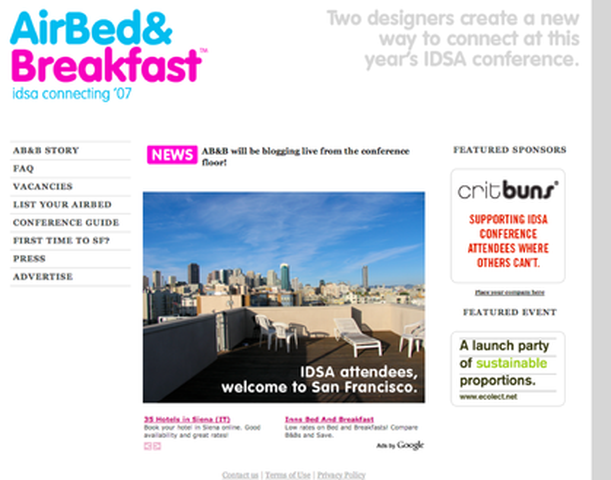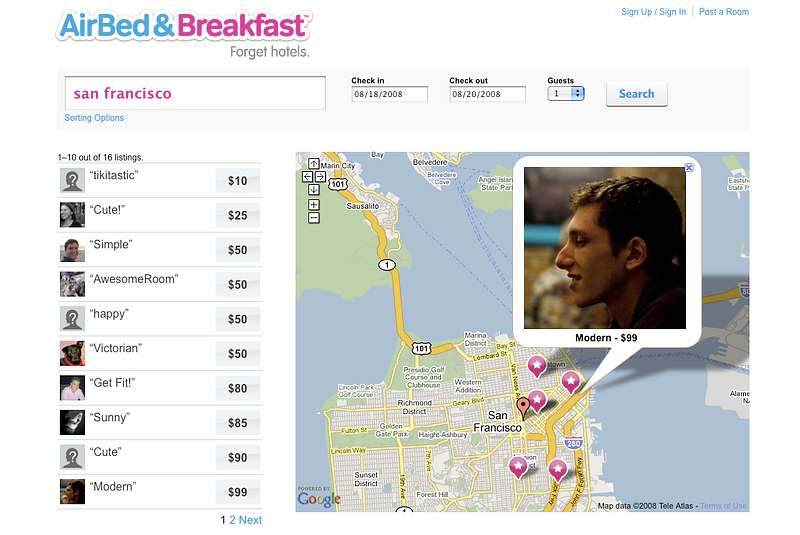It’s easy to look back at the inception of household names and see an air of inevitability. But the landscape during the early development phase for many companies was vastly different from how it is now.
Disrupters by definition change the market they enter. One thing they have in common is that they put a minimum viable product (MVP) in the hands of users as quickly as possible, then tested their assumptions against real data, and continued to iterate.
It’s often difficult for stakeholders to believe that starting with something so small is the best way to create something that will one day provide value to millions of users, but these case studies prove it. At Fueled, we believe the best way to build a successful product is by starting with the MVP. In this series, we look at startup success stories for insight on how to create the next big thing.
MVP Throwback: Airbnb
In late 2007, two product designers, Brian Chesky and Joe Gebbia, had a problem to solve: they needed help paying their rent.
The two also observed a second problem. In a city hosting frequent, highly attended conferences, it was difficult and expensive to find a hotel room. Conference attendees needed not just an affordable place to stay, but a place to stay period.
Chesky and Gebbia had some extra space in their apartment’s living room — at least enough to fit a few air mattresses. They thought: maybe a few people would be willing to pay to stay with them.
PRODUCT ASSUMPTION: STRANGERS WILL PAY TO STAY IN OUR HOUSE
To test their assumption, the founders played the role of the seller. Chesky and Gebbia tested this in the simplest way possible. They provided air mattresses in their living room, free wifi, free breakfast, and the promise of a unique networking experience with like-minded people.
They didn’t rent out a space or build new beds. They leveraged their existing assets in order to test their assumption as quickly as possible. Much as we might like to use a third-party tool or library in early prototypes, they minimized their cost — and therefore their risk — and arrived at a testable product quickly. From there, they could gather data and iterate going forward.
MARKET LANDSCAPE: COMPETING TRAVELER NETWORKS
Chesky and Gebbia weren’t the first onto the bed-exchange market. Couchsurfing.org was launched in 2004 by another San Franciscan, Casey Fenton. It had just shy of 4 million users by 2012 (Julian Assange was a member). The Couchsurfing model differentiated on one key component: it didn’t require payment. Guests could offer to cook a meal or clean, but there was no monetary component to the exchange.
To emerge as a viable platform with a critical mass of users offering and using rooms, they needed to do two things. First, it needed to demonstrate that there was a market for paid room rentals in a personal setting. Second, it needed to attract enough users to its specific platform to meet supply and demand in any location. Let’s see how they did it.

THE MVP: STRANGERS, AIR BEDS, FREE WIFI, AND BREAKFAST
Their MVP did not have a robust website or options to select multiple dates, locations, or prices. They targeted one demographic: tech conference attendees at a single sold-out conference. The pair didn’t need to give other options or account for every single use case. Chesky and Gebbia only had to confirm that a sufficient number of people were willing to rent an air mattress in their living room. Three people signed up and each agreed to pay $80 per night.
By building simply and learning at the earliest stages, they avoided what could have been a costly, feature-rich failure. It’s better to fail fast and readjust than to learn the same lesson after spending a ton of time and money.
ASSUMPTION 2: OTHERS WILL LET STRANGERS PAY TO STAY IN THEIR HOMES
In their initial product, Chesky and Gebbia played the part of the seller. Now with some positive data on the buyer side (a whopping $240), it was time to get some data on the seller side. To do so, they launched a new feature allowing hosts to list their space on the platform.

Again, instead of trying to optimize for every use case, they focused on hosts near high-profile events. They kept the site features and design minimal: users could now view available locations and prices on a map, and request to stay there for a negotiable price.
Despite a few false starts, the answer to their second core assumption was answered: hosts are willing to be paid to share their residence with strangers.
CONTINUAL ITERATION BASED DATA AND USER FEEDBACK
On their original website, you can see multiple paths that the AirBed & Breakfast team could have taken. The “CONFERENCE GUIDE” continued as their vestigial item, until the product proved it could expand further.
The “FIRST TIME TO SF?” section suggests something that could help travelers get to know their travel destination instead of just staying there. Fast forward to today, we can understand why Airbnb’s expanded service offerings include local “experiences”.
The photo of the home on the website shows how AirBed & Breakfast values location representation through images. This is clearly a large undertaking, to verify and professionally photograph properties. However they only arrived at this product decision after determining that off-putting photos were hurting guests’ willingness to stay in their locations.
LOOKING FROM THE PAST TO THE FUTURE
Today, AirBed & Breakfast goes by Airbnb. They’ve got a new logo, a new brand identity, and they’ve expanded outside of the web. Airbnb no longer focuses on specific conferences or events and is used by millions of hosts and guests worldwide. In 2014, Airbnb was valued at $10 billion. In 2024, they’re valued at more than $93 billion.
Airbnb still has many challenges. They will still need to adapt to user demand, and their relationships with the hotel industry, as well as local and state governments. But by starting out with a single idea, testing their assumptions quickly, and iterating based on data, Airbnb has become a major player in the sharing economy.
And to think they started with two guys letting strangers sleep on air mattresses in their living room.
